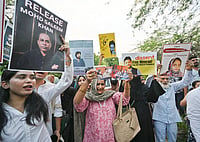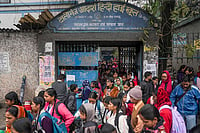At 4.30 that evening, Arya was told that her job was no more. A dearth of export orders had forced the shutdown of yet another factory. "I knew the mirror's breaking spelt bad tidings. Earlier I worried about fees, now it's food," she sobs.
Arya's story, however, is not about faith in signs or portents. It's about cold economic reality. And you don't need to believe in omens to know that we live in scary times.
For two years now, we have been constantly told about sluggish industrial growth, plunging profits, falling exports, stocks erosion, crashing property prices and a depreciating rupee. Friends and family have lost jobs, taken pay cuts and postponed purchases and holidays. Shops are empty, hotels look deserted and office spaces are getting vacant as people move in search of lesser rentals. Economists called this recession. It is the cyclical downturn that economies occasionally get into only to come back roaring, they said. With that, we felt reassured, if in part.
Now, however, some economists warn of a situation worse than recession. It's called stagflation. "All economic indicators—whether it is the GDP, industrial growth, business confidence, exports, agriculture or inflation—suggest that we are in the midst of stagflation," says Subir Gokarn, associate professor, Indira Gandhi Institute of Development Research. Explains Dr Wilima Wadhwa, executive director, Society for Economic Research & Financial Analysis, "Stagflation is scarier than recession. In times of recession, output falls and the economy contracts. But the good part is that the prices also fall, providing a healing touch. In stagflation, the economy contracts but prices are constantly shooting upwards. There's simply no trade-off."
What really makes this such a threat? Simply put, stagflation is a situation of a stagnant economy accompanied by rising inflation. What makes it scary, however, is the complex chain of reactions it triggers off in the economy. When prices rise in a stagflationary situation, the consumer moves down the value-chain, spending more on primary goods and cutting back on high-cost manufactured goods or using cheaper substitutes. This leaves producers with lot more unwanted inventories.
They react by cutting back on production, which often leads to layoffs. Apart from lesser spending, a higher level of unemployment creates a fear psychosis and a tendency towards increasing savings. Consumers save because they do not want to spend. Producers save because they don't want to invest, with not enough takers for their goods. So money gets parked in banks instead of going into productive channels that can stimulate the economy. Even the monetary policy then becomes powerless to stimulate demand. "If the government pumps money into the economy, it then goes towards stoking inflation rather than stimulating demand. That's the calamity of stagflation," points out Dr Amit Mitra, secretary-general, Federation of Indian Chambers of Commerce & Industry (FICCI).
So is the dreaded stagflation on the way, if it hasn't already arrived? Are we looking at a nasty downward spiral in output and demand while being haunted by the spec-tre of rising prices? Let's read the signs. First, inflation, especially over the last few months. Driven primarily by increasing food prices, consumer price inflation has been rising steadily from 14.8 per in July to 15 per in August to a five-year high of 16.3 per cent in September. By now everyone is familiar with the 400 per cent increase in the price of onions over the last year, and the panic buying it led to among consumers while hoarders capitalised on the shortage, sending the prices of other vegetables soaring as well. Part of the blame lay in an unusually bad harvest and part with bad administrative management.
But most have overlooked another culprit: the broad money supply that economists call M3, which rose to an unprecedented 20 per cent. The net result: even after all the market intervention given the political sensitivity of issue, the wholesale price index today hovers at 8.5 per cent, more than double the level it was at the start of the financial year.
Second, declining industrial production. In April-July 1998, the industrial growth rate slipped to a worrying 4 per cent, down 1.6 percentage points from the same period of 1997. The growth rate in manufacturing plunged to 3.7 per cent, against 5.6 per cent a year earlier. The biggest slowdown was in consumer durables, which inched ahead at 0.8 per cent, compared to 6.2 per cent. Growth in basic goods dipped from 7.7 per cent to 2.6 per cent, and in intermediate goods from 8.4 per cent to 5.3 per cent. This has been reflected in the corporate results declared for the first half of the financial year.
The aggregate turnover for 563 companies has grown at a niggardly 8.3 per cent. And while a modest 10.7 per cent increase in the interest burden helped gross profit rise 1.3 per cent, cumulative profit declined by 3.7 per cent.
Third, consumption pattern. Automobile sales are stagnant in most segments. Major hotels have slashed room rents to maintain occupancy and are focusing on increasing revenues from the food and beverages business. And with demand taking a beating, even the slight growth in the consumer durables sector shows signs of tapering off, while the non-durables sector is picking up speed.
FOURTH, productive investments. Commercial credit offtake continues to hover at a sluggish 13-14 per cent, implying that corporates are shying away from fresh investments. "Private investors want returns. They are not in business for charity. If there is no demand for their goods why should they take a lead?" asks Wadhwa. What's worse, public investment is also not likely to pick up. For one, the government is off its revenue collection target by as much as Rs 9,000 crore from excise alone. On the expenditure side, it anyway doesn't have any leeway given its commitment to interest payments, defe-nce and other priority areas.
This means that if it is to meet the cost of its political payouts like the rollback on urea prices, export subsidies and additional outgo on account of the Pay Commission, the government will have to increase borrowings. And more monetisation, in turn, will only stoke inflation.
Besides, agricultural growth is unlikely to cross 3 per cent, largely on account of crop damage due to the varying geographical and temporal spread of the monsoons. Exports between April and June 1998 were down 3.8 per cent over the same span last year. Capital flows are predicted to dip, with foreign institutional investors remaining uncommitted about the Indian stock market and foreign direct investment expected to be in the region of $3 billion. The only sector that may maintain its growth rate is the services sector, but then it is hardly likely to change the course of the economy.
Dr H. Sadhak, joint general manager, LIC Mutual Fund, has little doubt about the situation the economy is in. "A stagflationary situation has already emerged in India. GDP growth in 1997-98 declined sharply to 5 per cent from 7.5 per cent in 1996-97. It may fall further to 4.5 per cent in 1998-99. Employment is down, so is actual investment. Liquidity is up, bank credit expanding slowly, the price index is rising.... Stagflation is already staring at us in our faces."
What are the prescriptions? Technically, two. One is to increase money supply so that interest rates fall and consumers are tempted to spend and producers to invest. On the flip side, this strategy could well fuel inflation further, which would be a politically and economically suicidal outcome in the current situation. The second is the Keynesian idea of the government pumping money into infrastructure projects roads, bridges, power and the like so that people find jobs and producer have buyers for their inventories.
MOST experts plump for the latter prescription. "Tackling stagfla-tion requires the minimising of supply shocks. The current inflationary spiral could have easily been tackled had the government intervened to import onions at the right time. This would not have fuelled inflationary expectations and put a rein on prices. That's the supply-side remedy. On the monetary side, public expenditure must go up and stimulate the core infrastructure sector of the economy," says Wadhwa. FICCI'S Mitra is of the same opinion. "The only sensible way is to get all the power and road projects and the like off the ground," he says.
The government seems to agree, going by statements of intent. Last month, prime minister Atal Behari Vajpayee declared that two expressways one north-south and another east-west with total length of 7,000 km would be built. Also announced: five proposed world-class international airports, a new telecom policy and an innovative Internet policy. Finance minister Yashwant Sinha was also in the act, talking of automatic approval for all industries, freeing inter-corporate investments and indicating that foreign investors could invest up to 26 per cent in the insurance sector.
But are these measures enough to kickstart the economy? There are many hopefuls. "At least there's some direction," says economist Surjit S. Bhalla. He feels that external factors too will play a positive role. "The south Asian crisis is petering out. I think the rupee will be stable and as the cost of hedging falls, capital inflows will resume.
I see inflation down to 7 per cent in March '99 and economic growth back to 6 per cent," he says. Adds an optimistic Mitra: "The secretary to the prime minister, N.K. Singh, is himself monitoring Rs 500 crore infrastructure projects on a weekly basis to ensure that they get off the ground. Even if 10 such projects get implemented, it would bring Rs 5,000 crore into the market as demand for cement and steel. If that doesn't stimulate the economy, what will?" Not all are so optimistic, though. "All that has happened in the last six months is talk, more talk and cliches. Even if one were to believe that some action is happening, it will take at least 18 months for the economy to change course," says Wadhwa.
Even as experts debate, meanwhile, consumers and manufacturers seem to have made up their mind on where the economy is heading. Household savings are growing at 19. 3 per cent, against the Ninth Plan target of 18.9.per cent. Private corporate savings too are higher at 4.7 as against a projected 4.5 per cent. The message is clear: consumers are not eager to spend and manufacturers are not confident to invest. Looks like stagflation is here for an extended stay.


























